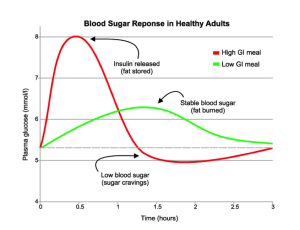In my last post (read here) I discussed how burning fat is a biochemical state that is controlled by hormones and has very little to do with eating less and exercising more. Flipping your biochemical switch from fat storage to fat burning is all about controlling insulin and cortisol levels. I offered these three simple rules for balancing blood sugar and therefore optimizing insulin levels:
- INCLUDE A SOURCE OF HIGH QUALITY PROTEIN AT EVERY MEAL AND SNACK
- LIMIT SUGAR AND EASILY DIGESTED CARBS
- EAT AS FREQUENTLY AS NECESSARY TO AVOID HYPOGLYCEMIA (ie, low blood sugar)
As you can see, Rule #1 is including high quality protein at every meal and snack. Lets first discuss how including protein with meals can help control insulin levels. To set the stage we have to understand the differences in how your body digests carbohydrates and protein.
When you eat a carbohydrate rich meal the food passes quickly through your stomach and goes straight to your small intestines. Once there the enzymes produced by your small intestines and pancreas quickly and efficiently break apart the carbohydrate into its simplest sugars and those simple sugars are absorbed directly into your blood stream causing a spike in blood sugar. This spike in blood sugar is what triggers the release of insulin. Insulin helps your body to move the sugar from your blood into organs and tissues and also flips the metabolic switch to fat storage so that any extra sugar can be saved for later as fat.
Now conversely, when you eat a protein rich meal it stops in the stomach for the first phase of digestion. The stomach produces acid and pepsin which get to work breaking apart the bonds between the amino acids in the protein. This process takes time and as the protein is slowly digested the stomach releases small squirts of the digestive juices into the small intestines. Once the meal reaches the small intestines it is quickly and efficiently broken down into its individual amino acids and absorbed.
Now what happens when you combine protein and carbohydrates? The whole meal slows down in the stomach so the protein can begin its first phase of digestion. As digestion occurs small squirts of digestive juices are released into the small intestines. These digestive juices contain carbohydrates and protein which are both quickly and efficiently digested and absorbed into the blood stream. But this time the carbs didn’t come through in one quick load, they are coming through in small squirts spaced over time. So instead of a large spike in blood sugar (red line below) there is a small rise that is maintained over time (green line below).
So as you can see protein helps to slow down digestion effectively turning the carbohydrate in your meal into a slow release capsule and tempering the blood sugar response.
Now there are a couple of important guidelines when including protein in your diet:
- I want to be clear that I am not recommending a high protein diet. I’m simply recommending protein with each meal and snack. An average 150 pound adult needs between 55-68 g protein each day. This is about 8-10 oz of animal based protein daily. A good rule of thumb for a portion size is about the size of a deck of cards or the palm of your hand. For example:
- Two eggs = 12-14g protein
- ½ pound ground beef = 28g protein
- Chicken thigh = 10g protein
- ¼ cup almonds = 8g protein
- I know we have all heard the phrase “You are what you eat” but have you heard the modification “You are what your meat eats”? This turns out to be quite accurate. Using cows as an example, the fat in the body of a grain fed cow is inflammatory and contributes to a host of chronic diseases. The fat in the body of a grass fed cow is anti-inflammatory (not to mention much lower in quantity in general and packed full of nutrients) and is considered part of a healthy anti-inflammatory diet. Eating beef, chicken and pork that is not fed grains but allowed to consume a natural “pastured” diet is a great way to balance blood sugar while maintaining the holy grail of the anti-inflammatory diet.
Healthy options for protein include (all organic preferably): raw nuts, raw seeds, legumes (soaked for 24-48 hrs and cooked slowly over low heat), eggs from pastured chickens, pastured poultry, 100% grass fed beef, pastured pork, lamb, venison and other wild game.
Some local resources for this type of high quality protein include:
- http://tarafirmafarms.com/
- http://www.pratherranch.com/
- http://www.marinsunfarms.com/
- http://www.ranchogordo.com/
Watch for my next post about Rule #2 for optimizing insulin levels!
~ Dr Tara


I’d like to find out more? I’d love to find out
some additional information.
Very good information. Lucky me I ran across your blog by chance (stumbleupon).
I have book-marked it for later!
I am a boxer and because of that protein has always been important to me for building muscle. But, I never realized the role it played on your insulin and blood sugar, especially with the help of carbs. The fact that protein and carbs help break down and slow down the whole process to help you better absorb protein is quite remarkable. Thank you for the good information!